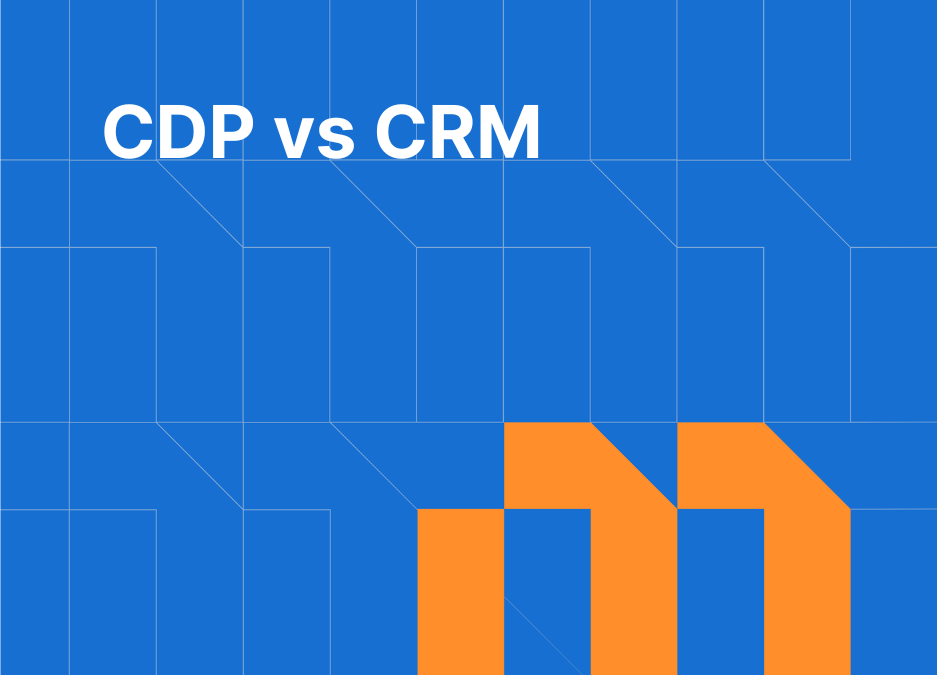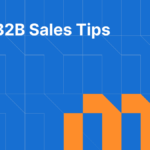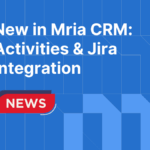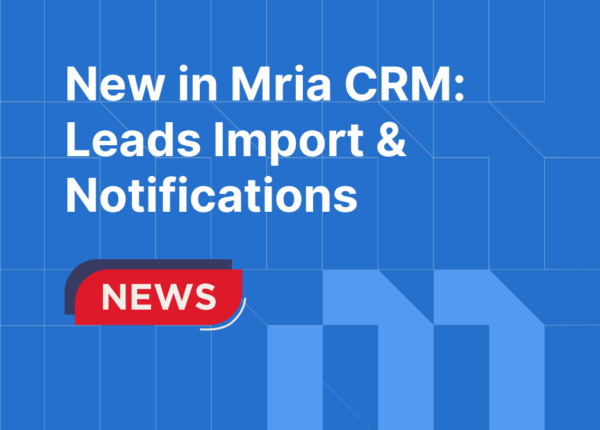Effectively using customer data is a complex challenge that requires knowing where to find it, how to interpret it, and how it supports your business strategy. Different goals call for different tools. While both CDPs and CRMs manage customer information, they serve distinct purposes in how they collect, process, and apply data.
A Customer Relationship Management (CRM) system focuses on managing direct interactions between a business and its customers. In contrast, a Customer Data Platform (CDP) automatically collects and unifies data from multiple touchpoints to better understand customer behavior across channels.
In this article, we’ll explore the key differences between CDP vs CRM, compare their features, and help you decide the best fit for your business goals.

Table of Contents
What is Customer Data Platform (CDP)?
A Customer Data Platform (CDP) is software that collects, segments, and activates customer data from various sources, creating a unified view of all customer activities, interactions, and touchpoints with your products. CDP is used mostly in omnichannel marketing communications for B2C, eCommerce, and service industries, where conversion depends on personalized interactions.
The primary purpose of a CDP is to centralize and organize customer profiles, making them easily accessible for marketing, sales, and customer service teams. It helps CRM marketers create hyper-targeted customer segments, predict behaviors, and launch personalized advertising campaigns.
What are CDP Functions?
If you have access to plenty of customer data but find it challenging to collect, analyze, and use it effectively, a CDP could be the solution. But the answer isn’t just one reason – a CDP is necessary to:
- Personalize messages – A CDP segments the audience to deliver precise offers that match the customer’s interests or remind them of a repurchase.
- Collect data from all channels – It collects data from websites, mobile apps, email campaigns, messengers, and other sources to create a complete customer profile.
- Build a unified customer profile – All user data, including personal details and purchase history, is stored in one place, eliminating duplication and simplifying analysis.
What is Customer Relationship Management (CRM)?
A Customer Relationship Management (CRM) system is a platform that helps businesses organize and improve interactions with both existing and potential customers. It collects data from direct customer interactions, which sales teams use to monitor leads, personalize communications, increase profit, and detect new sales opportunities.
CRM systems address several key business challenges by improving customer relationships, streamlining sales and marketing processes, and enhancing team collaboration. With CRM tools, businesses can:
- Support product development teams in creating better, customer-focused offerings
- Deliver personalized products and services at the right time and price
- Resolve customer issues more swiftly and effectively
RELATED: Customer Relationship Management Process: A Complete Guide
What are CRM Functions?
If you’re looking to support loyal customer relationships and increase business revenue, a CRM system is essential. Here’s why CRM is a must-have for any business:
- Centralize customer data – CRM systems help you gather, organize, and store customer data in one place, simplifying contact management.
- Improve customer interaction – By using CRM to track customer interactions and behaviors, businesses can personalize communication and provide timely responses, increasing customer loyalty.
- Boost sales and marketing – CRM enables sales teams to manage leads, track sales progress, and automate follow-ups, while marketing teams can run targeted campaigns for higher conversions.
Check our guide on CRM Features to Look For in 2025, ensuring you choose the right tools to enhance your customer management and drive business growth.
CRM vs CDP: Overview of Key Differences
The difference between a CRM and a CDP lies in how each platform handles customer data, their core purpose, and how businesses use them. Understanding CDP vs CRM is essential for choosing the right system for marketing, sales, or customer experience.
What Is the Difference Between CRM and CDP?
- Customer Data Platforms (CDPs) collect and unify customer data from multiple online and offline sources into a single, real-time profile used for marketing personalization and analytics.
- Customer Relationship Management (CRM) systems focus on managing direct customer interactions like emails, meetings, and calls, primarily for sales, marketing, and customer support.
While CRMs organize known customer interactions, CDPs enable a full 360-degree view of the customer by integrating behavioral, transactional, and demographic data across channels.
RELATED: ERP vs CRM: What’s the Difference and Which One Is Right for You?
CRM vs CDP: Purpose
Understanding the purpose of CDP and CRM helps define their role in your tech stack.
- CDP: Builds unified customer profiles by aggregating first-party data across platforms for personalized marketing and segmentation.
- CRM: Tracks and manages customer interactions to improve sales processes, service quality, and team productivity.
RELATED: Why Use a CRM? Straight Answers to Common Questions
CRM vs CDP: Data Storage
- CDP: Stores vast volumes of structured and unstructured data from multiple sources, creating a holistic customer profile.
- CRM: Stores data from direct interactions, typically structured around contact records, notes, and communication history.
CRM vs CDP: Data Collection Methods
- CDP: Automatically collects customer data from websites, mobile apps, emails, POS systems, CRMs, and more, in real time.
- CRM: Gathers data manually or semi-automatically through team activities like emails, calls, meetings, and form entries.
CRM vs CDP: Integration Capabilities
- CDP: Integrates with a wide range of platforms (advertising tools, CRMs, eCommerce platforms, POS systems) to unify data and activate marketing campaigns.
- CRM: Integrates with email, calendars, marketing automation, and support tools to streamline relationship management.
CRM vs CDP: Primary Users
- CDP: Used by marketing teams, data analysts, and customer experience specialists who need a single customer view for segmentation and personalization.
- CRM: Used by salespeople, account managers, and support teams to manage leads, track opportunities, and resolve issues.
CRM vs CDP: Core Functions and Features
- CDP: Unifies and enriches customer data, enabling real-time personalization, predictive analytics, and omnichannel targeting.
- CRM: Manages contacts, tracks sales pipelines, logs communication, and supports task automation for relationship management.
CRM vs CDP: Analytics and Reporting
- CDP: Offers advanced analytics with behavioral insights, lifetime value prediction, and segmentation reports.
- CRM: Focuses on reporting sales metrics, customer service KPIs, and pipeline performance dashboards.
CRM vs CDP: Pricing and Cost
- CDP: Typically more expensive, with enterprise-level pricing reflecting the complexity of data handling and integrations.
- CRM: More affordable and scalable, with plans suitable for small businesses to large sales teams.
CRM vs CDP: Ease of Implementation
- CDP: Requires technical setup, including data mapping, cleansing, and integration with multiple systems.
- CRM: Usually easier to implement with pre-configured templates and straightforward onboarding.
Common Misconceptions About CRM and CDP
Many organizations struggle to choose between a CRM and a CDP because they misunderstand the core purpose and limitations of each system. Here are common misconceptions that often lead to poor platform decisions:
1. “A CRM can do everything a CDP does.”
While some CRMs offer basic marketing automation features, they are not built to handle complex, large-scale customer data aggregation across multiple sources. CRMs typically manage structured, interaction-based data, while CDPs are designed to unify and activate massive amounts of behavioral and transactional data across channels.
2. “Only large enterprises need a CDP.”
Although CDPs are often associated with big brands, mid-sized businesses using multiple marketing channels (e.g., email, web, mobile, ads) can benefit greatly from a CDP’s ability to build unified customer profiles and drive real-time personalization. As CDP solutions become more accessible, smaller teams are adopting them earlier in their growth stages.
3. “CDPs replace CRMs.”
CDPs are not replacements for CRMs. Instead, they complement CRMs by enriching them with behavioral data and enabling marketing use cases that CRMs can’t support on their own, like dynamic segmentation, cross-channel targeting, or predictive modeling.
4. “CRM data is enough for personalization.”
CRM data usually reflects direct interactions: calls, emails, meeting notes. That’s not enough for sophisticated personalization. CDPs collect behavioral signals (e.g., web activity, app usage, purchase intent), giving marketers the depth and context needed to tailor messages and offers.
How to Choose CDP or CRM for Your Business?
Deciding whether to choose a CDP or a CRM depends on your business’s specific goals and how you plan to manage customer data.
When Choose CDP
A Customer Data Platform (CDP) is key when customer data volume grows significantly and comes from many different sources. Handling such large datasets manually is impractical. Advanced technologies like machine learning and neural networks help process and organize this information, enabling predictive analytics.
Here are three signs that your business needs a CDP:
- Your customer data is scattered across different channels and tools.
- You want personalized campaigns but lack resources for manual data management.
- You need better insights into customer behavior to customize your offers.
A CDP acts as a centralized “Smart Hub” that collects data streams from across your company’s tech stack for consolidation and further use. Automated data processing requires complex software, and CDPs are built to handle these requirements effectively.
Implementing a CDP is especially beneficial for medium and large businesses. For small companies, it may not be cost-effective yet. However, investing in a CDP is strategically sound if your company plans to scale, as it enables a significant upgrade in data management and customer concentration capabilities.
When Choose CRM
Customer Relationship Management (CRM) features like storing brief contact details, tracking customer pain points and needs, and maintaining sales history. This CRM functionality is enough to nurture relationships, grow your business, and create targeted campaigns.
Here are three signs that your business needs a CRM:
- Your sales reps are losing customers due to disorganized data.
- You want to improve your sales pipeline and increase conversion rates at every sales cycle stage.
- Your customers complain about slow responses or poor support.
The CRM market offers a wide range of custom tools to different business sizes and budgets. CRM systems are accessible for small businesses, entrepreneurs, and large enterprises alike. Any company looking for a well-organized sales process based on consolidated customer data can find a CRM solution that meets their needs, at least until their business grows and requires the more advanced capabilities of a CDP.
Read the latest guide with a checklist on how to choose the right CRM for your business.
When Use CDP and CRM Together?
CDPs and CRMs complement each other rather than replace one another. CDPs provide strategic insights for understanding and segmenting customers, while CRMs focus on managing direct customer relationships. Combining data from both creates a fuller customer view. Using CDP and CRM together enables smarter personalization and better customer management, especially benefiting large enterprises with complex audiences. can become one.
Decision-Making Framework: CRM vs CDP vs Both
To decide whether you need a CRM, a CDP, or both, consider the following framework based on your company’s needs and maturity level:
| Criteria | Choose CRM | Choose CDP | Use Both |
|---|---|---|---|
| Primary Goal | Manage sales pipeline, customer relationships | Unify and activate customer data for marketing | Sales and marketing alignment with real-time insights |
| Type of Customer Data | Interaction-based (emails, calls, notes) | Behavioral, transactional, demographic | All of the above |
| Data Sources | Limited, mostly internal | Multiple, including online and offline | Internal + external + third-party |
| Personalization Needs | Basic segmentation | Advanced targeting and personalization | End-to-end customer journey personalization |
| Primary User | Sales, support, account managers | Marketing, analytics, CX teams | Cross-functional teams |
| Company Size & Complexity | Small to mid-sized, simpler stack | Mid to large, omnichannel marketing | Growing or enterprise-level |
| Budget & Implementation | Lower cost, faster setup | Higher cost, technical setup required | Investment in unified CX strategy |
CDP vs CRM Use Cases by Team
CDPs are built to gather data from multiple sources, offering a complete customer profile. If you’re focused on customer-based marketing, a CDP offers more value. CRM systems are best suited for managing sales activities and tracking direct customer interactions, such as emails, calls, and meetings. If your priority is sales process management, a CRM is a better fit.
CDP vs CRM for Marketing Team
- CDP: Provides a unified, 360-degree view of customers by collecting data from various sources, enabling marketers to create highly personalized and targeted campaigns across all integrated channels. It helps with audience segmentation, predictive analytics, and real-time campaign activation.
- CRM: Offers marketing teams access to customer contact info and sales history, supporting lead management and tracking campaign responses, but with less focus on deep data unification.
CDP vs CRM for Sales Team
- CRM: Used as the primary tool for sales teams by managing customer contacts, tracking deals, scheduling follow-ups, and logging communications. It helps streamline the sales process and increase sales.
- CDP: Enhances sales efforts by providing richer customer insights and behavior data that can inform sales strategies, but it’s not typically used for direct sales activity management.
CDP vs CRM for Product Team
- CDP: Supports product teams by collecting behavioral data and usage patterns from multiple channels, giving insights into how customers interact with the product. This data drives informed product development, feature prioritization, and personalized user experiences.
- CRM: Provides limited product-related data, mostly around customer feedback or support cases logged, but is not designed for deep behavioral analytics.
CDP vs CRM for Support Team
- CRM: Essential for support teams, as it stores customer histories, previous interactions, and service tickets, enabling faster issue resolution and better customer service.
CDP: Can complement support by supplying additional customer context from various channels, helping support agents understand customer needs more holistically.
Learn more about Mria CRM for Jira, a cloud-based CRM solution that directly integrates customer and project workflows into one platform.
One More Thing to Know: CRM and CDP Are Starting to Converge
While CRM and CDP platforms still serve different core functions, the distinction between them is becoming less defined. Many CRM systems are now introducing features that were previously exclusive to CDPs, such as behavioral tracking, predictive analytics, and dynamic audience segmentation.
This trend reflects a growing demand for unified customer data and more intelligent personalization. For some businesses, especially those with simpler data requirements, modern CRMs may already provide enough CDP-like functionality to cover their needs without an additional platform.
However, these expanded capabilities do not fully replace the depth of data unification, identity resolution, or activation workflows that dedicated CDPs offer. Companies with complex data environments or advanced marketing needs will still benefit from using both systems together.
As the market continues to evolve, it is important to evaluate tools based on how well they align with your customer data strategy, rather than on feature lists alone.
RELATED: CRM Trends 2025: Everything You Need to Know
Conclusion
A Customer Data Platform (CDP) is designed to collect and analyze customer data. It is typically used by companies with large customer bases to segment audiences, automate personalized communication workflows, and improve marketing effectiveness. A Customer Relationship Management (CRM) system is a sales management tool used by sales teams to organize customer interactions, manage deals, and enhance customer service.
CRMs improve sales efficiency, while CDPs deepen customer understanding and enhance the overall experience. Using both CDP and CRM together doesn’t automatically guarantee explosive growth. In some cases, implementing a CDP can be costly and may not deliver significant benefits. To make the right decision, it’s important to assess your business goals, resources, and current situation. Consulting with experts before implementation is recommended.










